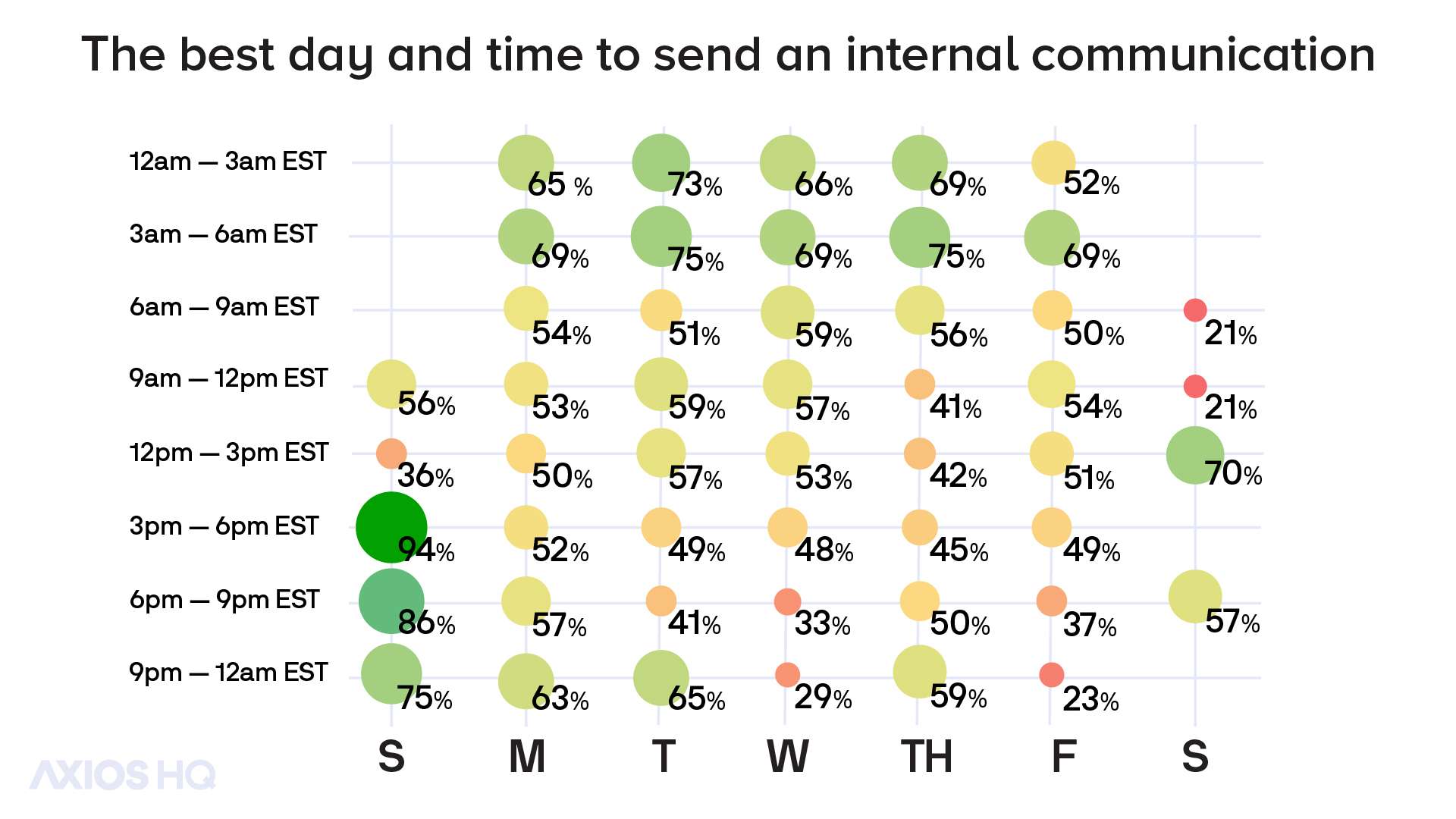What 8.7M email deliveries say about engaging staff communication

Some 90% of employees rank work-life balance among their top priorities, according to data from Forbes Health-Ipsos Monthly Health Tracker.
- Nearly 75% of employees are feeling burnt out. Inboxes are overloaded. People are overwhelmed. And leaders are looking for tools and insights to help them audit and optimize what they share so staff can stay focused, stay on task, and stay balanced.
Employers need to create guardrails, processes, and workplace norms that help their teams prioritize work-life balance. And while we recently went on a data-dive journey to help teams see and understand how to optimize “when” they share important internal communications, it had some surprising results, and we want to unpack what they might mean in the context of culture.
The best time to send an internal email
Axios HQ analyzed 8.7 million email deliveries between January 2022 and March 2023 from 215 organizations, and the results show Sunday sends from 3pm – 6pm EST earn the highest internal open rates — 94%.
- What’s important to know is send time does not equal read time — meaning those Sunday afternoon sends are landing at a low-traffic time, are likely a top-of-mind read for Monday morning, and tend to be more successful because of both.
- We also recognize, though, that sometimes even the impression that folks should check email outside of working hours can feel like an infringement — so finding your next best send window, even if performance is a bit lower, could leave your entire team happier.
To help you explore and pick which send windows will give your workplace communications the greatest lift in engagement without straining the bounds of work-life balance, we looked at average internal open rates in eight different send windows across each day of the week.

The right send window can get your messages seen and acted upon. But to truly get employees seeing your updates, this data has to be taken in tandem with several key factors that will impact your unique open rates across the board.
Other challenges in building balance with communication
Higher open rates can lead to better aligned staff who understand your goals and act on your directives. So it’s worth investing time to figure out when you can best engage your audience with the topics they want to hear about most — while still maintaining work-life balance. But that can be a challenge that comes down to several important considerations:
1. Employee roles: Employees are already overloaded with information, but it can become even more complex for individuals who work in warehouses, on factory lines, or in other frontline roles. They have fewer chances to check and read important updates, which can put them at risk of disengagement.
- Tune in to your employees’ daily routines, tasks, and locations. Take into account down times when hard-to-reach employees might be available to check in. Build a plan around those windows so folks can stay focused and balanced.
- See how Chobani handles internal communications for workers in various locations.
2. Mental Health: Roughly 40% of employees said they’re unable to balance work and personal commitments, and the more emails you send, the harder that becomes. Not to mention it can lead to burnout.
- Nail down the time that works for you and stick with it — remembering the lasting impact clear internal communication can have on your company’s mental health and ability to perform at their best.
3. Feedback and insights: A send window that creates effective staff communication and work-life balance for one organization is not one-size-fits-all. Your distinct industry, organization size, team preferences, and more all play a role. So you need to start with benchmarks, but learn to pressure test, collect feedback, and optimize so teams get what they need.
- Open up feedback loops with readers to get even more nuanced input on when the best send times for them may be — keeping a close eye on open rates as you experiment. Be ready and willing to readjust your strategy based on polls, surveys, and your metrics until you find the time slot that aligns with your objectives.
The bottom line: While companies may find success keeping internal communications at the start of the week and the start of each day, there is flexibility in your strategy. Use benchmarks, experiment often, seek feedback, find balance — and always prioritize your readers’ experience in their days, their weeks, and the critical balance that defines their workplace culture.
Go deeper: Read the full “Best time to send an internal communication” report





.webp)












.webp)

















